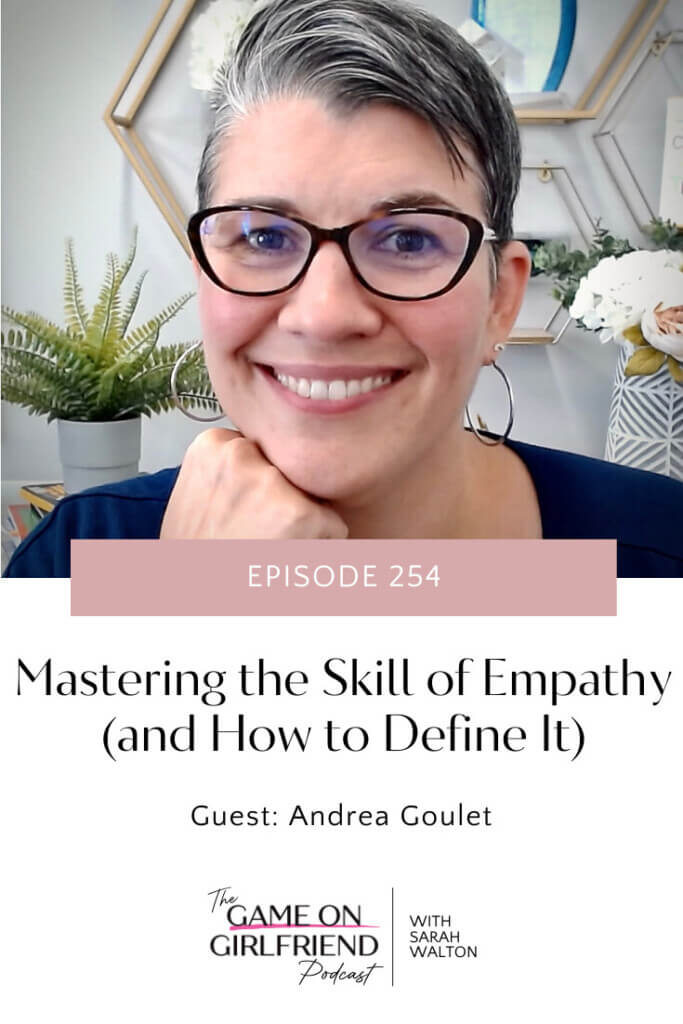Episode 254: Mastering the Skill of Empathy (and How to Define It) with Andrea Goulet

Have you noticed people cannot talk to each other? Have you noticed there is a them versus us? Andrea Goulet has studied empathy and she has studied it in a way I don't think I've ever seen before and she’s going to share her framework with us.
Andrea Goulet is on a mission to make empathy a core technical skill in software development. She is a sought-after international keynote speaker, experienced software entrepreneur, and award-winning industry leader. Her expertise centers on using empathy and effective communication to modernize legacy and mission-critical software systems.
Through her online courses, Andrea has taught over 75,000 students how to level up their empathy and communication skills to create better software. She is currently working on her first book, Empathy-Driven Software Development, where she aims to provide detailed mechanisms and system schematics of empathy's inner workings in a way that makes sense to engineers.
Empathy in the workplace
Andrea started her career in strategic communications, where she had a technical understanding about empathy and organizational psychology. She was approached by a friend to help build a software company and lead it as the CEO.
They landed on doing consulting together, (and spoiler!) also ended up falling in love with each other. (Hollywood screenwriter, where are you?)
“What we ended up having in building this business was the stereotypical dynamic of the salesperson and the engineer,” says Andrea. “They don't get along professionally. I did not understand how his brain worked. I had never worked in software.”
It was 2009, and they wanted to have a software company where empathy was at the core of the organization. She says they were advised not to do that to avoid being “laughed out of the industry.” Andrea doubled down.
“[Empathy] was the thing that drove business profitability, that drove business efficiency, that contributed to organizational effectiveness,” says Andrea. “Because I'm also a business person, too.”
And it wasn’t just in working with clients – empathy was needed in her daily operations with her now husband and business partner, Scott. She recalls an incident where she needed to pull Scott into a client meeting and walked over to his desk. Her ask pulled him out of his work process, which led to a visceral reaction.
When they sat down to discuss why he was so upset, he likened it to the movie Inception – saying he was nine levels down, and the action of interrupting him had ripped him from the solution he was on the cusp of solving.
The feeling of being completely ripped out of something Andrea could understand. And together they came up with a way to move forward, which became the subject of keynotes Andrea would later give at software development conferences.
“I've been pushed and pushed and pushed and pushed to explain it in more systematic way, to make it more contextualized,” says Andrea. “It just became like empathy was the heart of all of our work and all of our operations.”
How to define empathy
Over the course of her work, Andrea realized there was no consensus as to what empathy meant. Phrases like walking in someone else’s shoes, treating people how they want to be treated were often heard.
Andrea describes empathy as a functional system, meaning it’s in our bodies and is an evolutionary trait.
“The reason that we have evolved empathy as a species is so that we work together. And as a species we don't go extinct. So we are a hyper social species,” says Andrea. “Empathy is the mechanism that enables collaboration.”
She defines empathy is a functional system of emotion ,cognition, regulation and motivation that is influenced by external factors such as culture, context, capacity, and skill.
Andrea says seeking feedback is a key part of empathy – rather than just intuiting what the other person is going through without actually asking how they are feeling. She says when teams that are cognitively diverse can work together in a high functioning way, you get innovation, you get productivity, you get creativity. You solve problems faster because you're able to identify those things, implement hacks and solutions. But empathy really boils down to effective communication.
“You can't optimize the system in which you're in if one person is like, ‘I know everything, and I'm never going to change.’ ”
When empathy is harmful
Empathy can be harmful, as our individual empathy levels are not static. Andrea explains there is the intergroup empathy bias, which raises empathy levels when you are around people like yourself. But if you see someone as a threat, your empathy levels for that person can plummet.
“If we continue to operate in this way, where we think that empathy is only one form of expression, and if you are doing that, then you are virtuous. You’re the problem with society.”
Empathy model: Structured reappraisal
Andrea says to make empathy more concrete; she uses a model called structured reappraisal. A reappraisal is a psychological term for taking a beat before you act. And the pause can be learned and practiced.
What to do once you pause is where the structure comes in. The three rules are: collect, connect, and communicate.
The first thing you do is collect yourself. Are you regulated? What am you feeling? Are you operating out of compassion? What are your biases? What are you trying to communicate? Take a moment and anchor yourself in your own experience.
The second this is to connect. What are they thinking? What are they feeling? You're imagining someone else's perspective. You're inferring, but you're hypothesizing to communicate to move things forward.
So what you do there is you're actually creating a system. You’re going to predict the amount of miscommunication that is likely to happen. And then, think about the message that you want to send so that it's most likely to be received. That’s the communication piece.
So empathy is the thing that can help us navigate through all of those different systems and then create something that is more effective through these experiments and through implementing these improvements. But you can't get there unless both people are willing to do it.
Binge More Game On Girlfriend™ Podcast Episodes
GRAB MY FREE FREEDOM CALCULATOR SO YOU CAN:

Learn the exact number you need to feel FREE!
Know exactly what you need to do each day to make more money.
Make tracking your numbers easy with my revenue tracking tool (the same tool I use every day in my own business!)
Learn the TOP 2 mistakes most business owners make when it comes to tracking revenue
It's time to move from "fingers crossed" to clear and successful.




